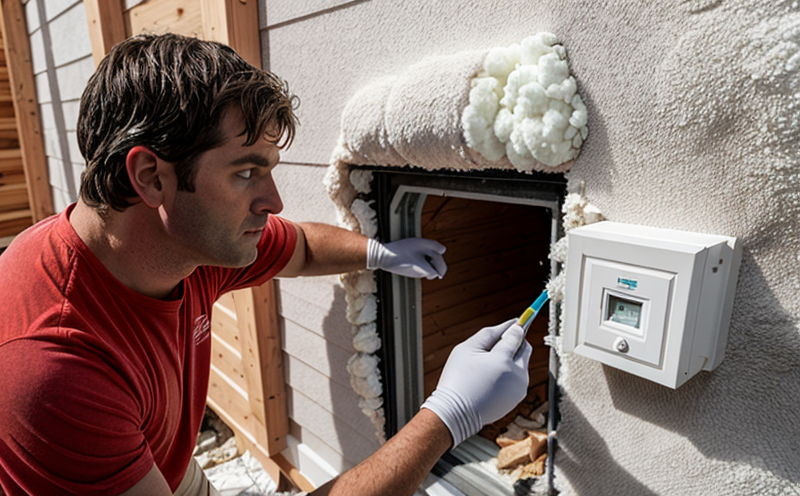EN 1604 Compressive Strength and Heat Transfer
The EN 1604 standard is a crucial guideline for testing insulation materials used in building and infrastructure projects. It evaluates the compressive strength of these materials under specified conditions, which is vital for ensuring structural integrity while also assessing their thermal performance.
Compressive strength tests are conducted to determine how much force can be applied before an insulating material fails. This test helps architects and engineers select materials that not only meet design specifications but also maintain safety standards during installation. Heat transfer measurements, on the other hand, assess the ability of the insulation to resist heat flow through it.
The standard is widely used in various sectors including construction, manufacturing, and quality assurance where thermal performance is critical. By adhering to EN 1604, organizations can ensure that their products meet the necessary standards set by regulatory bodies like the European Committee for Standardization (CEN).
This testing process plays a key role in the development of new insulating materials as it allows researchers and developers to understand the characteristics of different materials. Through this analysis, they can optimize formulations and processes leading to more efficient products.
The methodology involves preparing specimens according to specified dimensions and then subjecting them to compressive loads until failure occurs. Simultaneously, thermal resistance data is collected using standard heating and cooling cycles. These parameters are crucial for evaluating the effectiveness of insulation in real-world applications such as roofs, walls, floors, and other areas where heat loss or gain needs to be minimized.
Understanding these aspects helps professionals make informed decisions about selecting appropriate materials based on their compressive strength and thermal performance requirements. This ensures that buildings constructed using these materials comply with relevant building codes and achieve optimal energy efficiency.
| Application | Description |
|---|---|
| Roof Insulation | The compressive strength and thermal performance of materials used in roofing systems are critical for durability and energy efficiency. |
| Wall Insulation | Ensuring adequate compressive strength prevents structural damage while maintaining effective insulation properties. |
| Floor Insulation | A proper balance between compressive resistance and thermal resistance is essential for efficient floor heating systems. |
By employing this standardized testing procedure, manufacturers can demonstrate compliance with international standards and provide confidence to end-users regarding the quality of their products. This not only enhances market credibility but also supports sustainable practices by promoting energy-efficient solutions.
In conclusion, EN 1604 is an indispensable tool for those involved in building and infrastructure projects. It provides valuable insights into both mechanical properties and thermal performance aspects of insulating materials, thereby supporting informed decision-making processes across various industries.
Scope and Methodology
The scope of EN 1604 defines the testing parameters for determining the compressive strength and heat transfer characteristics of insulation materials. According to this standard, specimens must be prepared according to specific dimensions and then subjected to controlled compression until failure occurs.
For compressive strength tests, specimens are typically cylindrical in shape with a diameter equal to their height. The test setup consists of two parallel plates onto which the sample is placed between them. A hydraulic press applies gradually increasing pressure until the specimen fails under load.
The heat transfer portion involves measuring the amount of thermal energy passing through the material over time using established protocols. This measurement provides insight into the insulating properties of the product, helping to determine its effectiveness in retaining or blocking heat flow.
Standardization ensures consistency and reliability across different laboratories worldwide. Compliance with EN 1604 allows manufacturers to demonstrate adherence to international standards and enhances trust among stakeholders involved in construction projects.
Benefits
The benefits of adhering to the EN 1604 standard extend beyond mere compliance; they encompass several practical advantages that contribute significantly to project success. Firstly, it ensures that all materials used meet stringent quality control criteria set by recognized authorities.
Secondly, by following this standardized procedure, organizations can ensure consistent results across multiple testing facilities globally. This consistency is vital when comparing data from various sources or conducting inter-laboratory studies.
Thirdly, compliance with EN 1604 fosters innovation within the industry as it encourages continuous improvement of insulating materials through rigorous evaluation processes.
Moreover, adopting this standard promotes sustainability by facilitating the development and implementation of energy-efficient solutions that contribute positively to environmental conservation efforts.
In addition, adhering to such standards enhances brand reputation and customer satisfaction by providing assurance that products meet high-quality benchmarks. This aspect becomes increasingly important in competitive markets where consumers are becoming more environmentally conscious.
Industry Applications
| Application | Description |
|---|---|
| Retail | Ensuring proper insulation of retail spaces helps maintain optimal temperatures, enhancing customer comfort and satisfaction. |
| Healthcare | Adequate insulation in healthcare facilities improves patient recovery by maintaining stable internal environments. |
| Schools & Universities | Better thermal performance translates into lower operational costs and improved learning conditions for students. |
These applications highlight the versatility of EN 1604 in addressing diverse needs within the building sector. Whether it's improving occupant comfort, reducing energy consumption, or enhancing overall facility performance, this standard plays a pivotal role in achieving these goals.





